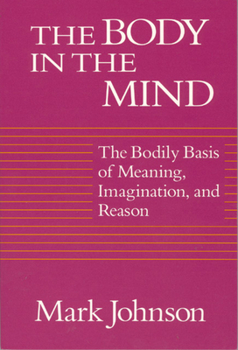The Body in the Mind: The Bodily Basis of Meaning, Imagination, and Reason
Select Format
Select Condition 
Book Overview
"There are books--few and far between--which carefully, delightfully, and genuinely turn your head inside out. This is one of them. It ranges over some central issues in Western philosophy and begins the long overdue job of giving us a radically new account of meaning, rationality, and objectivity."--Yaakov Garb, San Francisco Chronicle
Format:Paperback
Language:English
ISBN:0226403181
ISBN13:9780226403182
Release Date:April 1990
Publisher:University of Chicago Press
Length:272 Pages
Weight:0.97 lbs.
Dimensions:0.8" x 6.1" x 9.0"
Customer Reviews
2 ratings
Profound and thorough exposition of embodied philosophy and Cognitive Linguistics
Published by Thriftbooks.com User , 18 years ago
Of the work in embodied philosophy and cognitive linguistics, this by far the most careful, cogent, and through exposition. It is not light reading--it assumes a high level of education and a high degree of familiarity with Western philosophy, but it is profoundly rewarding. Johnson develops a theory of image schemas as the preconceptual links between our embodied experiences and our sophisticated abilities to use language, including the theory of conceptual metaphor he codeveloped with George Lakoff. He offers many different sources of evidence ranging from gesture to studies of epistemic modality in logic and linguistics to phenomenology to aesthetics and art. The second half of the book largely explores the philosophical, historical, and psychological elaborations of the notion of a schema. All in all, those searching for an exposition of how the repeated patterns of bodily experience shape cognition will be rewarded. The twenty-odd diagrams of image schematic patters are also highly revealing. Similarly, academically-minded skeptics who are unconvinced of the rigor and merit of the research programme he outlines with Lakoff in Philosophy in the Flesh should find this satisfying and challenging reading. The book is not without faults, but largely in the unacknowledged contributions of other strains of thought. For example, Johnson does not explore the relationship between image schemas and Wertheimer's theory of gestalt perception; nor does he acknowledge here any relationship to Merleau-Ponty or the Piagetian tradition of child development; and the Shepard-Metzler mental imagery studies of object rotation are only briefly mentioned. Such ommissions may be more a result stemming from a limited scope, however, as he has acknowledged such thinkers elsewhere.
Plato vs. Aristotle--Who is RIght?
Published by Thriftbooks.com User , 25 years ago
Do the senses inhibit are judgement or do the senses increase are judgment for a more objective reality? This basic arguement has been debated ever since the time of Ancient Greece. As more research shows, the philosophy of Plato is becoming more real. As children, humans begin to categorize their world, picking out certain characteristics and weeding out other characteristics that are body related. These experiences are image schemas which are non-cultural that everyone experiences but are either used or non-used depending on the social environment that enforces them. Therefore, the objective reality cannot exist since there are characteristics that are eliminated and others that are given importance. Johnson does a superb job in explaining the image schema, that is a most difficult concept to grasp. The mind is is part of the body, not separated from it as shown in this book.






